[ comments ]
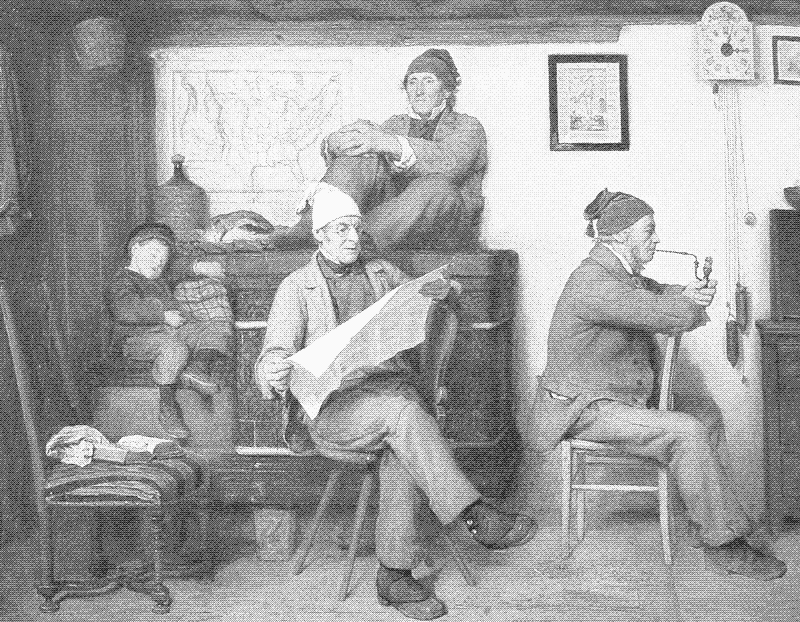
People gathering around a tile stove. Die Bauern und die Zeitung, a painting by Albert Anker, 1867.
These days, we provide thermal comfort in winter by heating the entire volume of air in a room or building. In earlier times, our forebear’s concept of heating was more localized: heating people, not places.
They used radiant heat sources that warmed only certain parts of a room, creating micro-climates of comfort. These people countered the large temperature differences with insulating furniture, such as hooded chairs and folding screens, and they made use of additional, personal heating sources that warmed specific body parts.
It would make a lot of sense to restore this old way of warming, especially since modern technology has made it so much more practical, safe and efficient.
Conduction, Convection, Radiation
Most modern heating systems are primarily based on the heating of air. This seems an obvious choice, but there are far worthier alternatives. There are three types of (sensible) heat transfer: convection (the heating of air), conduction (heating through physical contact), and radiation (heating through electromagnetic waves).
The old way of warming was based upon radiation and conduction, which are more energy-efficient than convection. While convection implies the warming of each cubic centimetre of air in a space in order to keep people comfortable, radiation and conduction can directly transfer heat to people, making energy use independent of the size of a room or building.
First, let’s have a look at the different methods of heat transfer in some more detail. Conduction and convection are closely related. Conduction concerns the transfer of energy due to the physical contact between two objects: heat will flow from the warmer to the cooler object. The speed at which this happens depends on the thermal resistance of the substance.
For example, heat is transferred much faster through metal than through wood, because metal has a lower thermal resistance. This explains why, for instance, a cold metal object feels much colder than a cold wooden object, even though they both have the same temperature.

Convective heat transfer from the body to the environment.
Conduction not only occurs between physical objects, but also between physical objects and gasses (like air), and between gasses mutually. Each physical object that is warmer than the air that surrounds it, heats up the air in the immediate vicinity through conduction. By itself, this effect is limited, because air has a high thermal resistance that’s why it forms the basis of most thermal insulation materials.
However, the air that is warmed by conduction expands and rises. Its place is taken by cold air, which is heated in turn, expands, rises, and so on. This plume of warm air that rises from every object that is warmer than the surrounding air, is called convection.
Radiation, the third form of sensible heat transfer, works in a very different way from conduction and convection. Radiant energy is transferred through electromagnetic waves, similar to light or sound. More precisely, it concerns the part of the electromagnetic spectrum that’s called infrared radiation. Radiation doesn’t need a medium (like air or water) for heat transfer.
It also works in a vacuum and it’s the most important form of heat transfer in outer space. The primary source of radiant energy is the sun, but every object on earth radiates infared energy as long as it has mass and a temperature above absolute zero. This energy can be absorbed by other objects with a lower temperature. Radiant energy doesn’t have a temperature. Only when it hits the surface of an object with mass, the energy can be absorbed and converted into heat.
Thermal Comfort at Low Air Temperatures
Because of the general use of central air heating (and cooling) systems, we have come to believe that our indoor thermal comfort depends mainly on air temperature. However, the human body exchanges heat with its environment through convection, radiation, conduction and evaporation (a form of “latent” heat transfer).
Convection relates to the heat exchange between the skin and the surrounding air, radiation is the heat exchange between the skin and the surrounding surfaces, evaporation concerns the moisture loss from the skin, and conduction relates to the heat exchange between a part of the human body and another object that it’s in contact with.
If the share of radiation or conduction in the total heat transfer increases, people can be perfectly comfortable at a lower air temperature during the heating season
In winter we can remain comfortable in lower air temperatures by increasing the share of radiation or conduction in the total heat transfer of a space. The opposite is also true: conduction and radiation can make people feel uncomfortable in spite of a high air temperature. For example, a person standing on a cold floor with bare feet will feel cold, even if the air temperature is a comfortable 21ºC (70ºF). This is because the body loses heat to the floor through conduction. A hot cup of soup in the hand, floor heating, or a heated bench have the opposite effect, because heat is transferred from the warm object to the body through conduction.
Radiant heat can make people comfortable at a lower air temperature, too. The obvious example is direct sunlight. In spring or autumn, we can sit comfortably outside in the sun wearing only a T-shirt, even if the air temperature is relatively low. A metre away, in the shade, it can be cold enough to need a jacket, although the air temperature is more or less the same. In summer, we prefer the shade. The difference is explained by the radiant energy of the sun, which heats the body directly when it is exposed to sunlight. This higher “radiant temperature”, which can be measured with a black-globe thermometer, allows thermal comfort at a colder air temperature in winter.
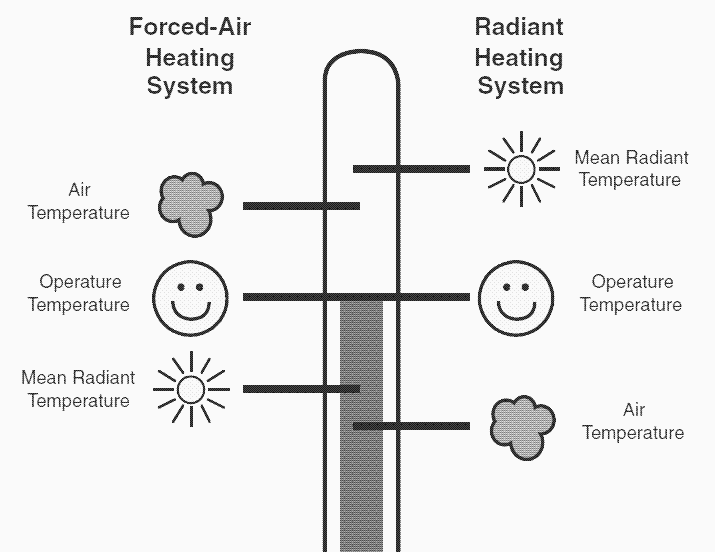
Radiant heating systems compensate a lower air temperature with a higher radiant temperature, while air heating systems compensate a lower radiant temperature with a higher air temperature. The operative temperature—a weighted average of both—can be the same. Source:, Richard Watson, 2008.
It should be noted that on earth, radiation always goes hand in hand with convection. Because air has little mass, the radiant energy of the sun doesn’t heat the air directly. However, it does so indirectly. The radiant energy of the sun is absorbed by the earth’s surface, where it is converted to heat. The warmer earth’s surface then slowly releases this heat to the air through the earlier described mechanisms of conduction and convection. In other words, it’s not the sun but the earth’s surface that heats the air on our planet.
The radiant temperature is equally important when heating a building, no matter which heating system is used. Indoors, the radiant temperature represents the total infrared radiation that is exchanged between all surfaces in a room. Radiant heating systems, which we will discuss later on, work in a similar manner as the sun: they don’t heat the air but the surfaces in a space, including human skin, raising the radiant temperature and providing thermal comfort at a colder air temperature. The use of radiant heating is more practical indoors, where environmental factors are under control. If a wind picks up outside, for example, the warming effect of the sun quickly disappears.
It’s not the sun but the earth’s surface that heats the air on our planet
A 100% radiant heating system doesn’t exist, because both the radiant heating surface and the irradiated surfaces make contact with the air and warm it by conduction and convection. However, this heating of the air has a delayed onset and is more limited than in the case of a direct air heating system. Likewise, an air heating system will also raise the radiant temperature in a space, because the hot air warms the building’s surfaces through conduction. But again, the increase of the radiant temperature is slow and limited in comparison to a radiant heating system.
As with conduction, radiation can also make people uncomfortable in spite of warm air temperature. If we are seated next to a cold window, our body will radiate heat to this cold surface, making us feel cold even when the air temperature is a comfortable 21ºC (70ºF). In short, neither a high air temperature nor a high radiant temperature are a guarantee of thermal comfort. The best understanding of the thermal environment in a space is given by the “operative temperature”, which is a weighted average of both.
The Old Way of Warming
Before the arrival of central air heating systems in the twentieth century, buildings were mainly heated by a central radiant heat source, such as a fireplace or a wood, coal or gas stove. Usually, only one of the rooms in a building was heated. But even within this room, there were large differences in comfort depending on your exact location in the space. While air heating distributes warmth relatively evenly throughout an area, a radiant heating source creates a local microclimate that can be radically different from the rest of the room.
This is because the energy potential of a radiant heat source decreases with distance. It’s not that the infrared waves become weaker, but that they become more dispersed as they are fanning out from a specific source. This is shown in the two illustrations below, which appear in Richard Watson’s “Radiant Heating and Cooling Handbook”. The drawing on on top shows the radiant heat distribution (or “radiant landscape”) in a room, seen from above, which is warmed by a forced-air heating system. The average radiant temperature in the space is 20ºC (68ºF). Except for the influence of a cold window surface (at the top of the illustration), the radiant temperature is relatively constant throughout the room.
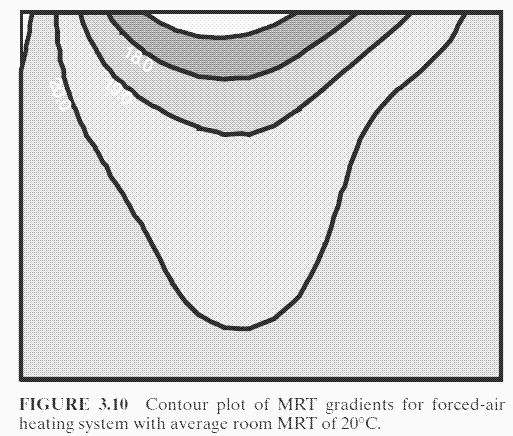
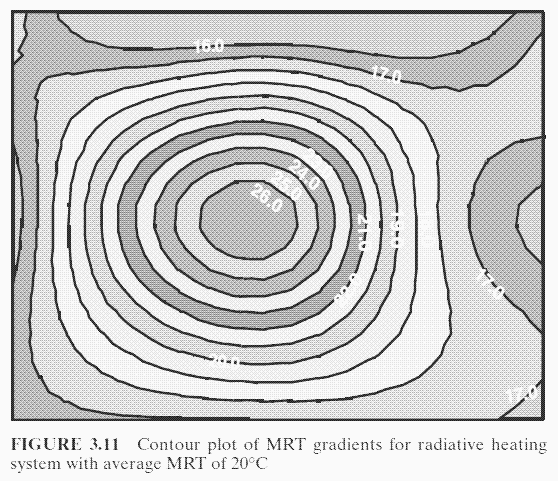
Source: Radiant Heating and Cooling Handbook. Richard Watson, 2008
The illustration below shows the same room, again with a mean radiant temperature of 20ºC (68ºF), but now heated with a radiant heat source which is located at the centre of the ceiling. It concerns an electric longwave infrared panel, a new technology that we will explain in the second part of this article, but a fireplace in the middle of the room would give a similar result. The radiant landscape is now very different. The highest radiant temperature is measured in the middle of the room, right below the heating panel. The radiant temperature then decreases rapidly in concentric circles towards the sides of the room. The difference between minimum and maximum radiant temperature is much larger than in the case of an air heating system.
In an air-heated room, it doesn’t matter much where you are. In a room heated by a radiant heating source, location is everything.
Of course, a different location of the radiant heating surface, or a combination of two or more radiant heating surfaces, would again present a very different radiant landscape. Furthermore, as with solar radiation, other objects can throw shadows, which means that even the location of the furniture can have an effect on the heat distribution in a room. Also note that the heterogeneous distribution of the radiant temperature will be somewhat tempered by the homogeneous character of the air temperature, no matter which heating system is being used.
Energy-Efficiency
In an air-heated room, it doesn’t matter much where you are. In a room heated by a central radiant heating source, location is everything. The mean radiant temperature can be optimal, but the radiant temperature in parts of the space may be too low. But the opposite is also possible: the mean radiant temperature can be too low, while at certain locations the room is perfectly comfortable. This is the ancient principle of spot or zone heating, which is impossible to realize with an air heating system. Instead of heating the entire space, our forefathers only heated the occupied parts of a building.
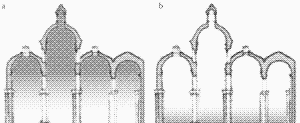
Air heating (left) versus radiant heating (right) in a church building. Source: Fabric-friendly heating, Dario Camuffo.
A similar thing happens on the vertical plane. Warm air rises, so that most heat ends up under the ceiling, where it is of little use. With radiant heating, it’s perfectly possible to only heat the lower part of a space, no matter how high the ceiling is. Radiant heat doesn’t rise, unless the radiant heating surface is aimed upwards. In conclusion, instead of heating the entire volume of air in a space, a radiant heating system can heat only that part of a space which is occupied, which is of course much more energy efficient.
Unless the room is very small or very crowded, only a very small part of the energy used by an air heating system benefits people. On the other hand, almost all the energy used by a radiant heating system is effectively heating humans.
Local Insulation
A problem with the heterogeneous indoor climate of old times was radiant assymetry—the difference in radiant temperature between distinct parts of the body. A person sitting in front of an open fire will receive sufficient radiant heat on one side of their body, while the other side loses heat to the cold air and surfaces at the opposite half of the room. The body can be in thermal balance—the heat loss on one side equals the heat gain on the other—but if the temperature differences are too large, thermal comfort will not be obtained.
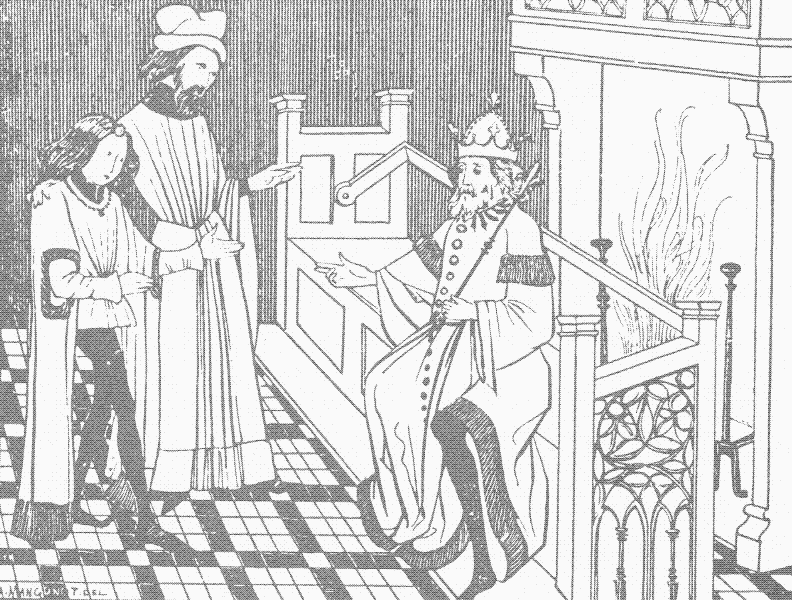
A bench with adjustable backrest. Source: Dictionnaire de l’ameublement et de la décoration depuis le XIII siècle, 1887-1890
The problem is illustrated on the engraving above. The back of the bench could be switched from side to side. By regularly turning the body to the fire and then away from it, both the front and the back of the body could be heated alternately. Although radiant assymetry can be an issue with forced-air heating systems, it’s much more likely to appear in spaces that are warmed by a a radiant heat source. In historical buildings, the difference in surface temperatures was aggravated by the fact that building surfaces were not insulated. Drafts, another cause of local thermal discomfort, were also a problem in old buildings, because they were anything but air-tight.
To create a comfortable microclimate without radiant assymetry or draft, our forefathers supplemented local heating with local insulation
To create a comfortable microclimate without radiant assymetry or drafts, our ancestors supplemented local heating with local. One example was the hooded chair. This chair, which could be upholstered or covered with leather or wool blankets, fully exposed people to a radiant heat source, while protecting their back from the drafts and the low surface temperatures behind them.
At the same time, the shape of the furniture ensured that a greater share of the radiant heat emitted by the fire was effectively used: the chair was heated directly by the fire through radiation, and this heat was transferred to the person sitting in it. Recent research has shown that the insulation value of these types of chair amounted to at least 0.4 clo, which corresponds to the insulation value of a heavy pullover or coat. Some hooded chairs could host more than one person.
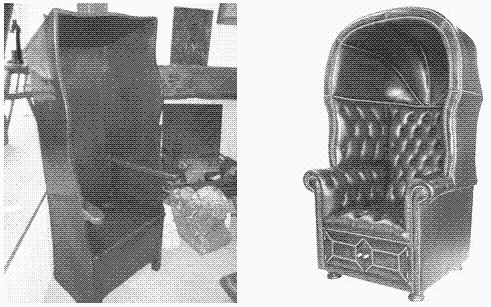
Hooded chairs from the nineteenth century. Sources: Period Oak Antiques (left) and Polyvore (right).
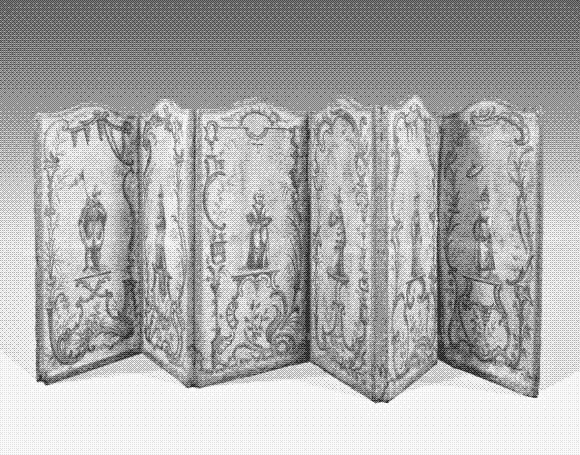
A folding screen for winter use. Source: Alain Truong.
An additional solution, which could also be used alone, was the folding screen. The folding screens used as winter furniture were insulated with fabrics or built with heavy wood panels. They could be placed behind an insulated chair, or behind a table, for instance. Like the hooded chair, the folding screen protected the back of a person against drafts and cold temperatures, creating a comfortable microclimate.

A sitting area close to the fireplace (Source: The English Fireplace).
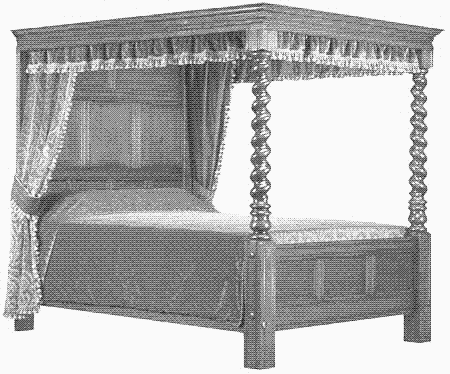
A four-poster bed (Source: Wikipedia Commons).
A third example of local insulation were special sitting areas close to the fireplace. These could be benches placed between the fire and the side walls of the fireplace, or a niche in the wall with a built-in seat. In both cases, a person would lean against a wall that was warmed by the fire and protected from drafts. In some cases, the fireplace itself was placed in a room-inside-a-room. In the bedroom, which often remained unheated, yet another piece of furniture was aimed at providing a microclimate: the four poster bed, which had a canopy and thick curtains. When the curtains were closed, drafts were eliminated and body heat was trapped inside.
Portable Heating Systems
The apparent downside of spot heating is that you have to be in a specific location in order to be comfortable. In earlier times, the family gathered around the fireplace or the stove when no physical work had to be done, or when the body had to be warmed up after a long stay in a cold environment. Other locations in the room, as well as unheated rooms, were better suited for activities which required a higher metabolism. People were “migrating” throughout the room and throughout the house in search of the climate that suited their needs best.
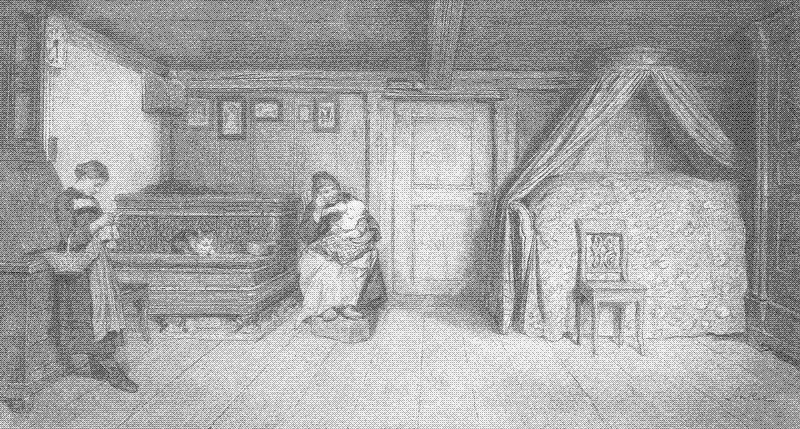
Familienszene in einem Interieur, a painting by Albert Anker, 1910
However, the use of radiant heat sources and local insulation were also complemented by portable heating sources which transferred heat through radiation, convection and/or conduction. These could be used to further increase thermal comfort in the presence of a central heat source, and were also helpful in bringing warmth to other locations. Portable heating systems were designed especially to heat the feet or the hands: the parts of the body that are most sensitive to cold.
Personal heating sources allowed people to enjoy the heat from the central fireplace in unheated rooms, or even outside the house
An example is the foot stove, a box with one or more perforated partitions, which contained a metal or earthenware bowl or pan filled with embers from the fireplace. The feet were placed on top of the stove and the often long garments worn in those days increased the effect of the small heating device: the warmth was guided through a skirt or a chamber coat along the legs to the upper body. The upper part of the stove was made of wood or stone, as these materials have low thermal conductivity to avoid burns.
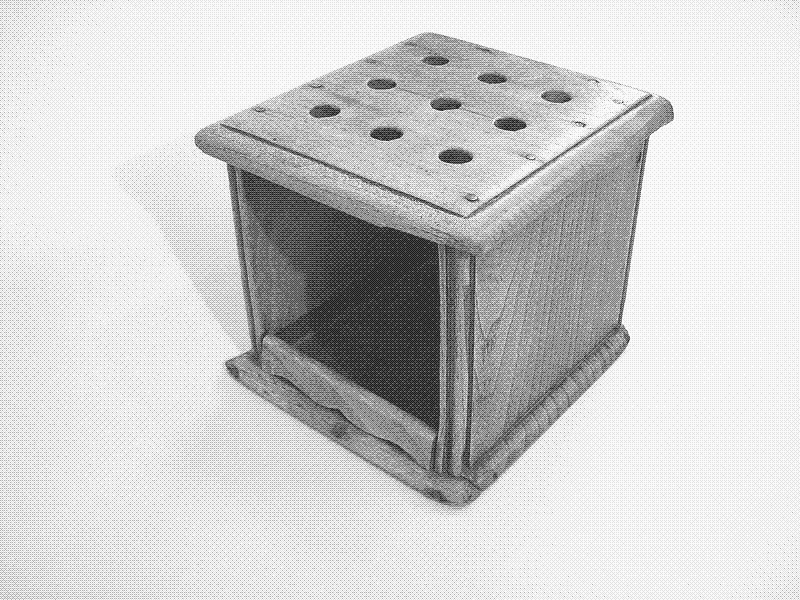
A Dutch foot stove (Wikipedia Commons).

“Young woman warming her hands“, a painting by Caesar van Everdingen.
In many cultures worldwide, similar heat sources were used for warming the hands. They were made from metal or ceramics and were filled with embers from the fireplace, or with coal or peat. These personal heating sources also allowed people to enjoy the heat from the central fireplace or stove outside the house. They were taken in unheated coaches and railcars, or to Sunday Mass. Poor people made use of heated stones or bricks, or even heated potatoes put in coat pockets.
For heating the bed, people made use of brass bedpans with a long handle which were shoved underneath the mattress. Some beds had a bed wagon: a large, wooden frame designed to hold a pot of glowing fuel in the centre of the bed. In the 19th century, following the arrival of the public water supply, the use of ceramic hot water bottles became common — water is a much safer heat medium than smouldering fire. These devices, which were often protected by a fabric cover, were used as foot warmers, hand warmers, or bed warmers.
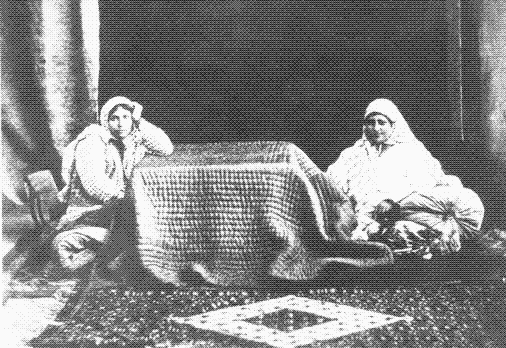
An Afghan “Korsi”. Source unknown.
Some peoples took the concept of the foot stove one level higher. The Japanese had their “kotatsu”, a movable low table with a charcoal heater underneath. A thick cloth or quilt was placed over the table to trap the heat and the whole family slid their legs under the table, sitting on the floor. As with the European and American foot stoves, contemporary clothing increased the effect of the device. The heat of the charcoal burner was transferred through the traditional Japanese kimono, warming the whole body. Similar heating devices were used in Afghanistan (such as the “korsi”), as well as Iran, Spain and Portugal.
Conductive Heating Systems
Some historical radiant heating systems also transferred heat through conduction, further improving efficiency and comfort. More than 3,000 years ago, the Chinese and the Koreans built heating systems which were based on trapping smoke gases in a thermal mass. The northern Chinese “kang” (“heated bed”) was a raised platform made from stone, masonry or adobe, which occupied about half of the room. As the name indicates, the kang was in the first place a heated bed, but the platform was also used during the day as a heated work and living space. The “dikang” (“warmed floor”), which was typical in North-Eastern China, worked in the same way as the kang, but had a larger floor area.
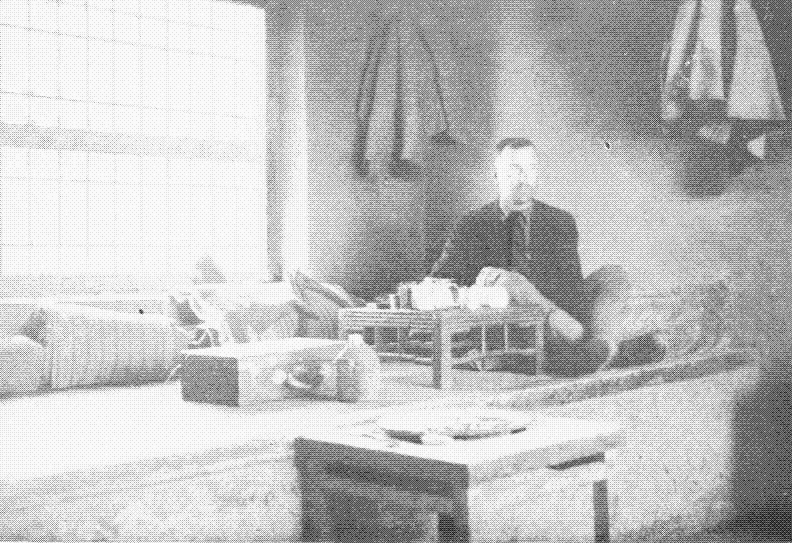
A Chinese Kang, photographed in the 1920s. Source: Wandering in Northern China, Harry A. Franck.
The Koreans used the “ondol” (“heated stone”), which was a wall-to-wall platform. A similar heating system in Afghanistan, the “tawakhaneh” (“hot room”) is possibly the oldest of these systems: its use may date back 4,000 years. In all these systems, the heat of an open fire was led underneath the platform to a chimney at the other side of the room. Both the fireplace and the chimney could be in the room or in adjacent rooms. The heat of the hot smoke gases was transferred to the thermal mass of the platform, which slowly released the warmth to the space. Conduction was as important as radiation and convection in the total heat transfer.
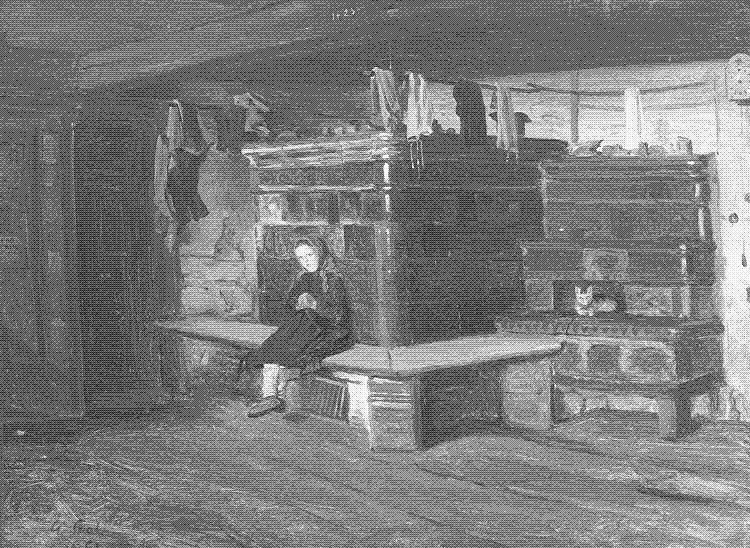
Blick in eine Schwarzwaldstube mit kleinem Mädchen auf der Ofenbank, a painting by Georg Saal, 1861.
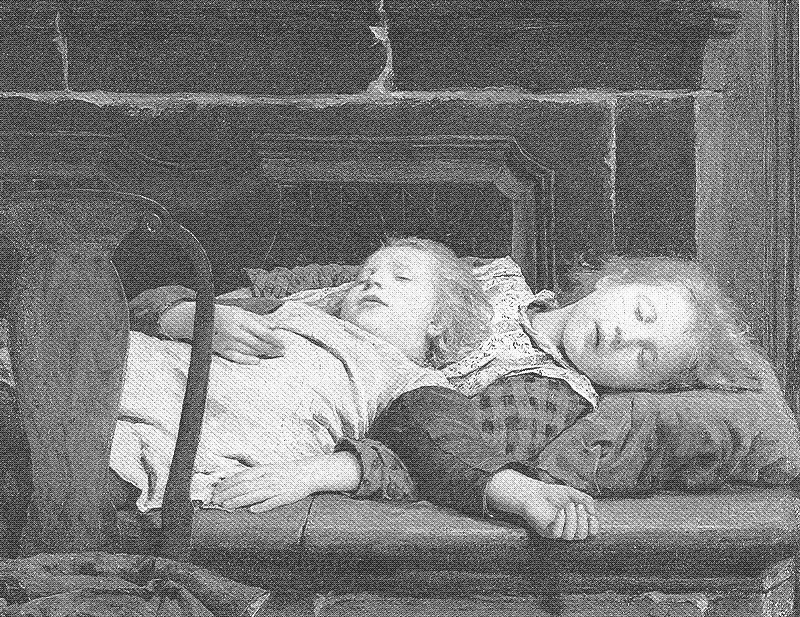
Auf dem Ofen, a painting by Albert Anker, 1895
These ancient Eastern heating systems are somewhat reminiscent of the European tile stoves that appeared in the middle ages. Tile stoves (or “masonry heaters” as they are known in the USA) are heat accumulating wood stoves that make use of a high thermal mass to burn wood at very high temperatures, which is cleaner and more efficient. The smoke gases are trapped in a labyrinth of smoke channels, transferring most of the heat to the masonry structure before leaving the chimney.
Tile stoves produce a large share of radiant heat, but on top of this they allow heat transfer through conduction, as many tile stoves had built-in platforms to sit or sleep on. Even if these platforms were not there, wooden benches were placed next to the stove so that one could lean against the warm (but not too hot) surface.
Why We Also Need Modern Technology
In conclusion, all historic heating systems used radiation and/or conduction as the primary modes of heat transfer, while convection was merely a by-product. It makes good sense to return to this concept of heating, but that doesn’t mean that we have to go back to using fireplaces and carrying burning embers around the house. While the old concept of heating is more energy-efficient, the same cannot be said of most of the old heating devices.
While the old concept of heating is more energy efficient, the same cannot be said of most of the old heating devices.
Fireplaces, for one thing, are hugely inefficient, because most of the heat escapes through the chimney. They also suck in large amounts of cold air through cracks and gaps in the building envelope, which cools the air indoors and introduces strong drafts. Owing to this, fireplaces can even have negative efficiency as far as the air temperature is concerned: they can make the room colder instead of warmer. Stoves do better, but they remain relatively inefficient and have to be fired regularly, just like a fireplace. And for both options, air pollution can be substantial.
The (improved) tile stove is the only ancient heating system that can still be recommended, but we have far more options now, such as electric and hydronic radiant and conductive heating systems. These are more efficient, more practical, and safer than the heating sources of yesteryear. In the next two articles, we investigate how the old way of warming can be improved upon by modern technology, and how much energy could be saved.
Kris De Decker. Edited by Jenna Collett.
To make, please send an e-mail to solar (at) lowtechmagazine (dot) com. Your e-mail address is not used for other purposes, and will be deleted after theis published. If you don’t want your real name to be published, sign the e-mail with the name you want to appear.
Sources (in order of importance):
- Stralingsverwarming: Gezonde Warmte met Minder Energie, Kris De Decker, 2015
- Keeping Warm in a Cooler House. Creating Comfort with Background Heating and Local Supplementary Warmth (PDF). Historical Scotland Technical Paper 14, Michael Humphreys, Historic Scotland, 2011
- Radiant Heating and Cooling Handbook (Mcgraw-Hill Handbooks), Richard Watson, 2008
- Human Thermal Environments: The Effects of Hot, Moderate, and Cold Environments on Human Health, Comfort, and Performance, Third Edition, Ken Parsons, 2014
- The Book of Masonry Stoves: Rediscovering an Old Way of Warming, David Lyle, 1984
- History of radiant heating and cooling systems, part one. Robert Bean, Bjarne W. Olesen, Kwang Woo Kim, in “ASHRAE Journal”, January 2010, pp. 40-47
- Adaptive Thermal Comfort: Principles and Practice, Fergus Nicol, Michael Humphreys & Susan Roaf, 2012
- Dictionnaire de l’Ameublement et de la Décoration depuis le XIII siècle, Henry Havard, 1887-1890.
- Foot warmers: hot coals, hot water. Home Things Past.
- Bed warmers. Old & Interesting.
- Muff warmers & other antique hand warmers. Home Things Past.
- Körperwärmespender. Website.
[ comments ]
